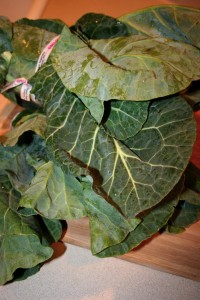If you grew up down south, Collard Greens were probably a staple in your diet. But, for us yankees (as my southern grandfather called us northerners) Collard Greens may be totally foreign to you. So here is a Closer Look at Collard Greens, followed with Collard Green recipes posted later this week.
How to choose the best Collard Greens?
Collard Greens are in season from November to April. Look for leaves that are bright green and crispy with stout stalks, not yellowish or wilted.
What are the nutritional benefits of Collard Greens?
Collard Greens are low in carbs and packed rich with vitamins A, C, K, E and folate. They also contain a significant amount of omega-3 fatty acids, calcium, and dietary fiber.
How do I prepare Collard Greens?
Both the stalks and leaves can be eaten. The leaves and stalks should be washed thoroughly first. You then cut the leaves into small strips. I most commonly sautee the greens in a little olive oil in a frying pan with a little minced garlic, salt, pepper, and lemon juice. You can then add the sauteed leaves into soups, stews, or eat them as a side dish. You can also eat them raw blended with other salad greens or include some raw leaves in your fruit smoothie (trick here: more fruit than veggies and you won’t even taste the veggies).
Stay tuned this week for recipes using Collard Greens!
Sources: http://nutritiondata.self.com/facts/vegetables-and-vegetable-products/2410/2


